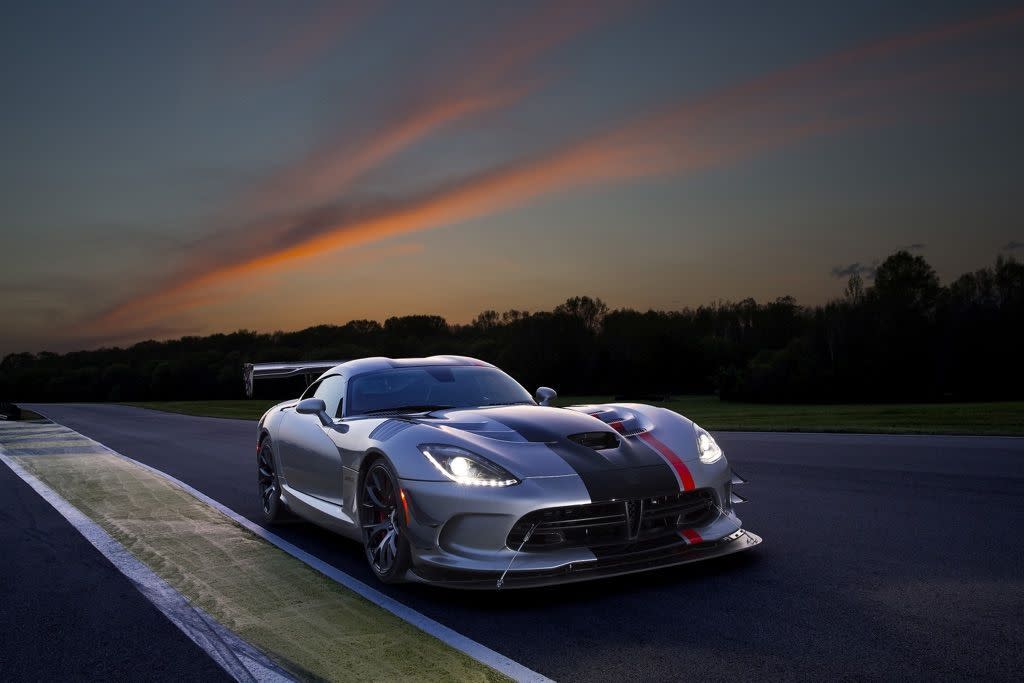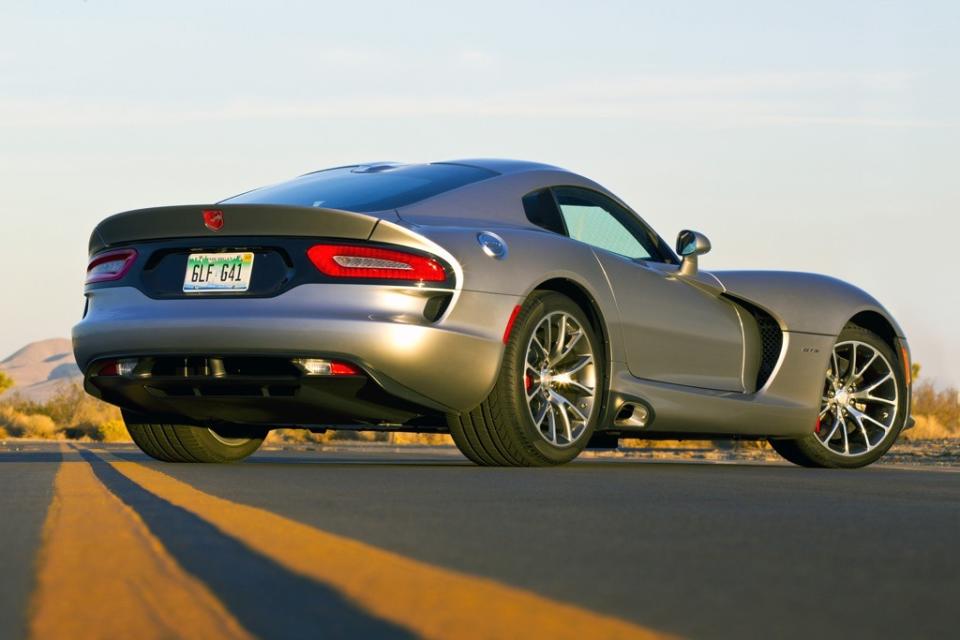The Dodge Viper Needs To Die

According to a product plan revealed in a tentative deal between Fiat-Chrysler and the United Automobile Workers, the Dodge Viper supercar is on the verge of death. The only way the venerable Viper can survive past 2017 is if a legitimate business case is made for its continuation.
The problem is, there isn’t one.
When Dodge (or SRT, depending on what polo the execs were wearing that day) brought the Viper back in 2013 after a three-year hiatus, it did so with an ambition of selling 1,600 units annually. To achieve this, Dodge/SRT planned on taming the super car’s infamous habits: “I want the new Viper to be a more forgiving car to drive and accessible to more people,” said Ralph Gilles, SRT’s then-CEO. “We’ve never had stability control on a high-performance car, which is about to happen on the new car.“
The cabin was now civilized, festooned in the same leather Ferrari uses, and the engineers said your legs wouldn’t melt if you drove it for more than ten minutes. At the new car’s first drive event at Sonoma Raceway, I lauded its ability to retain that inherent Viperness while feeling less like a V-10-powered death trap. Soon after, I spent two weeks with the 645 horsepower Viper GTS at home. I even went balloon shopping in it. People threw themselves into the road in front of me, seemingly content to die by serpent. Camera phones flashed in every direction. The attention it drew was almost disconcerting. I imagined this was what life was once like for David Hasselhoff.

And there were many problems. While your right leg would indeed no longer melt, it did still get rather toasty. To even it out, the side exhaust would deliver third-degree burns every time you tried to climb out—if you could get out.
The engine note retained a quality John Deere would approve of. The ride was as harsh as a go-kart. At over $120,000, the Viper was rather expensive when compared to, say, a Corvette Z06. And while there was now a quality navigation and radio in place, you couldn’t hear any of it because the noise within the cabin was so deafening it made your ears bleed. After 30 minutes, you wanted to get out. But as we’ve established, that’s not possible.
It was clear, then, that this newest generation Viper was much of the same as its forebears. Tamed, to a degree, but still mighty raucous—a car only for those with cash to burn and leg hair to match. So it came as no surprise when Dodge failed to meet its sales targets; in 2014, just 760 Vipers were sold. Through September 2015, despite a $15,000 price drop, only 503 units have left dealerships.
That price drop came in the wake of Viper production being halted at its Conner Avenue Assembly plant in Detroit. America’s homegrown supercar lay stagnant on showroom floors, and for more than two months, zero cars were built until demand caught up: “[The Viper] was never intended to be a high-volume car,” said Dodge’s CEO, Tim Kuniskis. “It’s always been intended to be a very high-performance, exclusive car.” Indeed, Kuniskis dubbed the Viper a “halo car” for Dodge, one that—regardless of sales—was vital in branding the company to its buyers and differentiating it within the Fiat-Chrysler empire. Dodge was to become aggressive, sinister even; cars for enthusiasts by enthusiasts.
This made perfect sense, except that the Viper isn’t Dodge’s halo car. That title goes to the 707-horsepower Challenger and Charger Hellcats. In a year’s time, the ludicrously obnoxious and wildly wonderful Hellcats became the darling of the automotive media; Yahoo Autos named it our Enthusiast Car of the Year. Buyers were paying way over sticker to get one—that is, if they could find one.

The poor Viper was left out; its more muscular, yet fatter, brothers had stolen its thunder. No one outside of the core fan club cared that the Viper was faster on a track, or leaner, or better handling. Because Hellcat.
The last-ditch attempt to set things right arrived recently with the new Viper ACR, a barely street-legal track monster that, in my opinion, is far more capable than the new Corvette Z06. It’s brilliant, a masterpiece even, but it’s highly niche—not a car that can save a low-selling model from the accounting department.
Should Conner Avenue Assembly, where the Viper is largely hand built, shut down, the case for building the Viper elsewhere looks weak. It would be silly to shift production to a new plant, taking resources away from a model that might actually contribute to the bottom line; while it’s not clear whether this latest generation Viper has broken even, it’s hard to imagine it’s not losing money. Meanwhile, Hellcat sales, production and prices will rise this year.
Let’s be sensible: Dodge should just kill the Viper and be done with it. Cut the losses and move on from fighting a battle it can’t win. The only way for the Viper to compete would be to copy the Corvette—develop an affordable, (relatively) mass-market base model with a smaller engine and automatic transmission, and build high-performance variants from there. But that would likely take a minimum of $100 million, and there’s no guarantee it will actually work.
Plus, it would be fundamentally wrong.

The Viper is crude and impractical in a way that’s not acceptable in $60,000 Vettes and Mustangs, let alone rides that cost double that. And yet the Viper’s faults are also its attributes. It has a soul, and character to spare. Every time you climb aboard it’s an experience, something that, over beers, you can share with fellow gearheads and they’ll completely understand its charm.
It’s not simply a car that draws a crowd in a parking lot. It’s focused, and it remains incredibly capable on a racetrack. So capable that it embarrasses many of Europe’s best at three times the price. The Viper ACR is the most capable street-legal track car America has ever made, and if it paid a visit to the Nurburgring, it wouldn’t surprise me if it broke the outright production car record.
Johnny Sixpack, who looks purely at horsepower numbers and declares that “only an idiot would spend over $100,000 on a Viper when you can buy a more powerful Hellcat and a lifetime supply of Bud Light and still have money to spare” won’t get it. Most people, in fairness, will never get the Viper.
But we do. We, the enthusiasts. The people that see past the numbers. Those that can appreciate a car’s deficiencies in its unwavering effort to succeed at speed. A car that sees an array of doubters and backbiters among the bean counters and bench racers, and proudly raises a middle finger to all.
In this era of modern motoring, machines like the Viper seldom exist because car companies don’t have the balls to delve past the bottom line and uncover the magic that’s being produced at places like Connor Avenue. The Viper may well die in 2017. And logically that makes sense. But we, the people, will have lost one of America’s finest creations—even if we’ve spared the hair on our legs.

